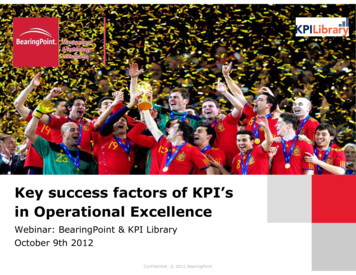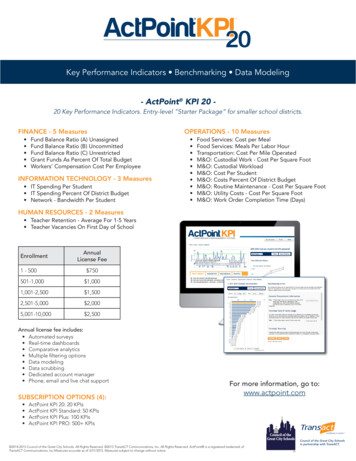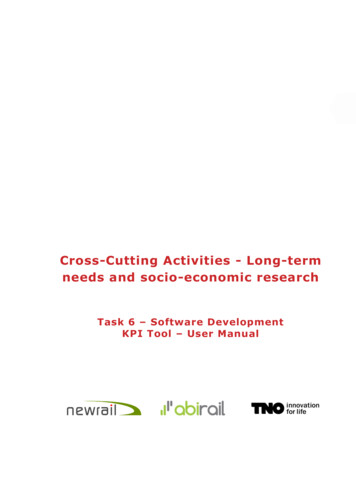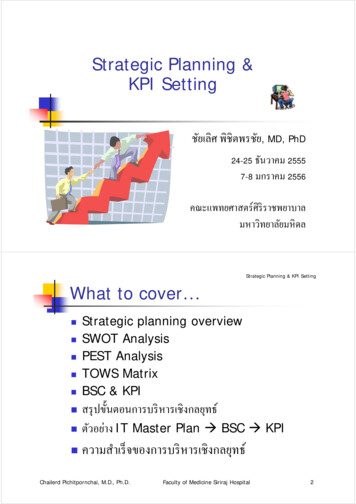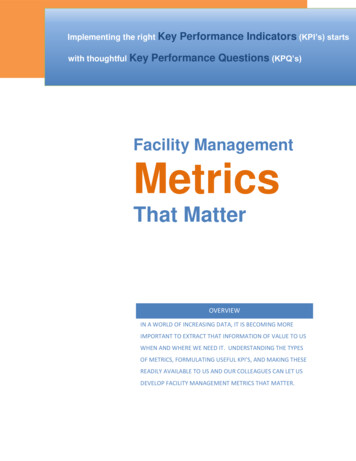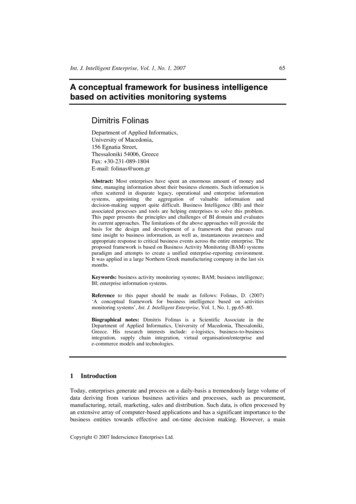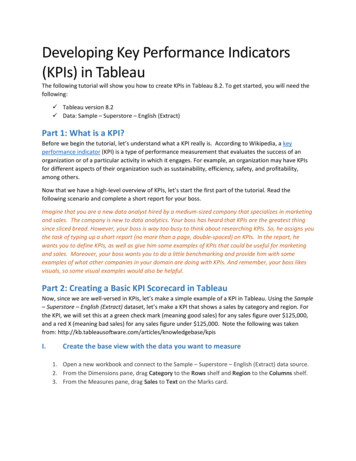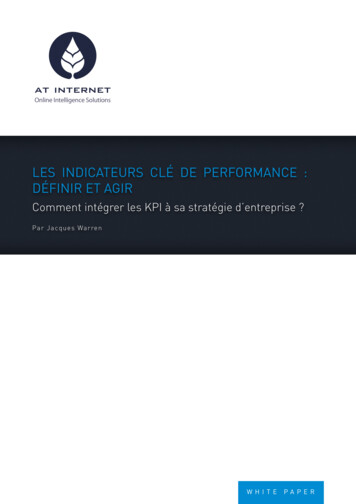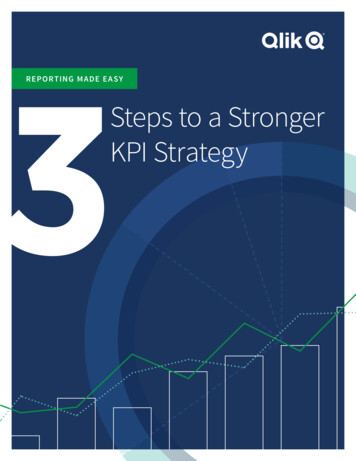
Transcription
Electronic Report to the Board2017-2022 Strategic KPI Framework:Proposed Performance TargetsGF/B36/ER08A7 March 2017For Board DecisionPurpose of the paper: To set out proposed revised performance targets for the 2017-2022 Strategic KeyPerformance Indicator Framework for recommendation to the Board.GF/B36/EDP09: Performance Targets for the 2017-2022 Strategic Key Performance IndicatorFramework
Part 1: Decision Point1.Based on the rationale described below and in the accompanying PowerPoint (GF/B36/ER08B)the following decision point is recommended to the Board for approval.Decision Point GF/B36/EDP09: Performance Targets for the 2017 – 2022 StrategicKey Performance Indicator Framework1.The Board notes the additional analysis to develop performance targets for the2017 – 2022 Strategic Key Performance Indicator (the “KPI”) Frameworkapproved by the Board in June 2016 under decision point GF/B35/EDP05 andset forth in Annex 1 to GF/B35/ER05 (the “Strategic KPI Framework”).2.Based on the recommendation of the Audit and Finance Committee and theStrategy Committee, as set forth in GF/B36/ER08A and GF/B36/ER08B, theBoard:a. Approves the performance targets where proposals are complete;b. Approves the proposed interim indicator proposals for KPIs 5 and 9c; andc. Agrees with postponing its review and approval of performance targetsfor KPIs 6a, 6b and 6e until the final Board meeting of 2017.Part 2 - Relevant Past DecisionsRelevant past Decision Point Summary and ImpactGF/SC02/EDP06:Recommendation on PerformanceTargets for the 2017-2022 StrategicKey Performance IndicatorFramework (March 2017)The Strategy Committee (SC) agreed to recommend thefollowing to the Board for approval: (i) performance targetsfor KPIs 1, 2, 3, 4, 6c, 6d, 6f, 8, 9a, 9b and 11; (ii) interimindicator proposals (i.e., definitions and performancetargets) for KPIs 5 and 9c; and (iii) postponement of thereview of performance targets for KPIs 6a, 6b and 6e.GF/AFC02/EDP04:The Audit and Finance Committee (AFC) agreed toRecommendation on Performance recommend performance targets for KPIs 7, 10 and 12 to theTargets for the 2017-2022 Strategic Board for approval.Key Performance IndicatorFramework (March 2017)GF/B36/DP09: PerformanceTargets for the 2017 – 2022Strategic Key PerformanceIndicator Framework (November2016)11The Board requested a further opportunity to review theproposed performance targets. Board constituencies wererequested to submit a final round of feedback to theSecretariat, and the leadership of the Audit and FinanceCommittee (AFC) and Strategy Committee (SC) wererequested to: (i) determine the performance targets to beaddressed by each committee based on their ecisions/GF/B36/DP09/Electronic Report to the Board7 March 2017GF/B36/ER08A2/23
Relevant past Decision Point Summary and Impactmandates; and (ii) establish an advisory group to work withthe Secretariat to present revised performance targets to theAFC and SC for recommendation to the Board.GF/SC02/EDP03:Recommendation on PerformanceTargets for KPIs 1, 2 and 8 the2017 – 2022 Strategic KeyPerformance Indicator (October2016)The Strategy Committee reviewed the Secretariat’s proposedperformance targets for the 2017 – 2022 Strategic KeyPerformance (KPI) Framework and agreed to recommendthe performance targets for Strategic KPIs 1, 2 and 8 to theBoard, expressed as point estimates together withuncertainty ranges. In doing so, the Strategy Committeeacknowledged the approach for deriving the performancetargets for Strategic KPIs 1, 2 and 8, including the modellingassumptions and key inputs.GF/AFC02/DP05 andGF/SC02/DP05: Recommendationon Performance Targets for the2017 – 2022 Strategic KeyPerformance Indicator (October2016)The Audit and Finance Committee and Strategy Committeereviewed the Secretariat’s proposed performance targets forthe 2017 – 2022 Strategic Key Performance (KPI)Framework and agreed to recommend the performancetargets that were complete and presented at the committees’October 2016 meetings, including interim proposals forStrategic KPI 5 and 9c. The committees agreed that theStrategy Committee would then review the performancetargets for Strategic KPIs 1, 2, 8 and 9b prior to theNovember 2016 Board meeting to discuss and issue arecommendation to the Board on these targets. Thecommittees also agreed to recommend deferring theperformance targets for the measures associated withStrategic KPIs 6a, 6b and 6e until 2017.GF/B35/EDP05: 2017 – 2022Strategic Key PerformanceIndicator Framework (June 2016)2The Board approved the Strategic KPI Framework for 2017– 2022, as presented in Annex 1 to GF/B35/ER05. TheBoard directed the Secretariat to present the Board with theStrategic KPI Framework’s performance targets for approvalat the final Board meeting in 2016.GF/B34/EDP04: Approval of 2016Targets for the 2014 – 2016Corporate Key PerformanceIndicator Framework (January2016)3The Board approved the 2016 performance targets, notingspecific revisions to the performance targets for KPI 7(Access to Funding) and KPI 10 (Value for Money). Havingacknowledged the Secretariat’s response to requests by theBoard for additional analysis on certain indicators, theBoard directed the Secretariat to implement proposedmanagement actions to improve performance, and tocontinue towards identifying lessons that could inform thedevelopment of the next Corporate Key PerformanceIndicator Framework.GF/B33/DP07: Remaining Targetsfor the 2014 – 2016 Corporate KeyPerformance Indicator Framework(March 2015)4Under the 2014 – 2016 Corporate Key PerformanceIndicator Framework, the Board approved updatedperformance targets for Key Performance Indicators 6, 12and 16 after additional analysis conducted by the Secretariatfollowing the Board’s approval of the updated 2014 – 2016Corporate KPI /Knowledge/Decisions/GF/B34/EDP04/4 F/B33/DP07/23Electronic Report to the Board7 March 2017GF/B36/ER08A3/23
Relevant past Decision Point Summary and ImpactGF/B32/DP10: Approval of theGlobal Fund Corporate KPIFramework 2014-2016 (November2014)5The Board approved the updated Corporate KPI Framework,acknowledging the methodological work required to finalizecertain indicators as agreed. The Board also approved theavailable performance targets for 2015, as well as the plan topresent the remaining 2015 performance targets forapproval at the Thirty-Third Board Meeting, as set forth inGF/B32/24.a – Revision 2. The decision point to approvethe updatedperformance targetscontainedinGF/B33/04B completedtheremainingactionitem from GF/B32/DP10.GF/B30/DP7: The Global FundCorporate Key PerformanceIndicator Framework for 20142016 (November 2013)6The Board approved the KPI Framework for 2014-2016 asset forth in GF/B31/7 – Revision 1. The Board asked forannual reports on these indicators, and whereavailable, for interim results to be made available throughthe information dashboard.Part 3 - Action Required2.The Board is presented with the enclosed 2017-2022 Strategic Key Performance IndicatorTargets (the “Targets”), as well as interim indicator definitions for Key Performance Indicators (“KPI”)5 and 9c, for approval. The Board is also requested to approve the postponement of its review andapproval of Targets for KPIs 6a, 6b and 6e until the final Board meeting of 2017. The proposals havebeen reviewed and recommended by the Audit and Finance Committee (the “AFC”) and the StrategyCommittee (the “SC”), which have each been allocated responsibility for recommending differentTargets, according to their respective committee mandates, as follows:a.The AFC is responsible for overseeing and recommending Targets for Strategic KeyPerformance Indicators (“KPI”) 7, 10 and 12; andb. The SC is responsible for overseeing and recommending Targets for KPIs 1, 2, 3, 4, 5, 6, 8, 9,and 11.3.Board approval of the Targets, and the interim indicator definitions for KPIs 5 and 9c, will allowthe Secretariat to proceed with development of data systems and protocols to begin reporting on the2017-2022 Strategic Key Performance Indicator Framework (the “Framework”). First reporting againstthis Framework is scheduled for the first Board meeting of 2018.Part 4 – Discussion4.The Global Fund’s 2017-2022 Strategic Key Performance Indicator Framework was developeddirectly in line with the Global Fund’s 2017-2022 Strategy, Investing to End Epidemics, incorporatingsignificant inputs from Board constituencies and technical partners. This Framework was approved bythe Board via electronic decision point following the 35 th Board Meeting nd.org/Knowledge/Decisions/GF/B30/DP07/Electronic Report to the Board7 March 2017GF/B36/ER08A4/23
5.The Framework consists of twelve Strategic KPIs to measure progress towards the strategy’stargets and objectives set out for the next six years. Underpinned by the strategic objectives, themission-level impact and service delivery goals will be tracked as follows. KPI 1 specifically tracks progress against an estimated number of lives saved and a reductionin new infections/cases; and KPI 2 monitors delivery of the high impact services required to meet impact goals.6. Measurement of Strategic Objective 1: Maximize Impact Against HIV, TB and malaria,will focus on the extent to which the Global Fund is targeting its investments to optimize impact. KPI 3 measures the extent to which Global Fund investments match country “needs” in termsof disease burden and economic capacity; KPI 4 complements KPI 3 and monitors whether funding decisions within country diseaseprograms are designed to maximize impact; and KPI 5 tracks coverage of services for key populations.7. Strategic Objective 2: Build Resilient & Sustainable Systems for Health, aims toimprove the performance of strategically important components of national systems for health. KPI 6 is proposed as an aggregate of several implementation indicators measuring progresson strengthening priority areas of national systems for health; and KPI 7 tracks the extent to which systems for health are strong enough to effectively use thelevel of funding required to address their disease burden.8. Strategic Objective 3: Promote and Protect Human Rights & Gender Equality, aimsto reduce human rights barriers to service access, and to reduce gender and age disparities in health. KPI 8 is proposed as an indicator of reduced gender and age disparities in health; and KPI 9 measures progress in establishing programs to reduce human rights barriers to access.9. Achieving Strategic Objective 4: Mobilize Increased Resources will require evidence ofincreasing and sustainable financial and commodity resources. KPI 10 measures progress towards mobilizing increased resources for health from currentand new public and private sources; KPI 11 advances the current indicator tracking domestic financing to assess the extent towhich domestic commitments to invest in health are ultimately fulfilled by governments; and KPI 12 assesses both the availability and affordability of health technologies as a result of theMarket Shaping efforts being pursued with partners including UNITAID.10. In consultation with experts and technical partners, full development of KPI methodologies,identification of indicator baselines, and analysis required to set ambitious but achievable performancetargets was carried out. After recommendations for approval for these targets from AFC(GF/AFC02/DP05) and SC (GF/SC02/DP05 & GF/SC02/EDP03) the Board, at its 36th Board Meeting(GF/B36/DP09), requested a further opportunity to review the ambition of the performance targetsproposed before approval.Electronic Report ta further opportunity to review the ambition of the performance targetsproposed before approval.Electronic Report to the Board7 March 2017GF/B36/ER08A5/23
11. Board constituencies were requested to submit a final round of feedback to the Secretariat, and theleadership of the AFC and SC were requested to:a.Determine the performance targets to be addressed by each committee based on theirrespective mandates; andb. Establish an Advisory Group to work with the Secretariat to present revised performancetargets to the AFC and SC for recommendation to the Board.12. The Secretariat response to the feedback received was shared with the Board and the AdvisoryGroup established in December 20167. Chaired by the Vice Chairs of the AFC & SC the Advisory Groupheld a series of discussions over the December 2016 to February 2017 period, and conducted a detailedreview of the methodology employed in setting performance targets and the underlying supporting data.A report of the Advisory Group is included as Annex 1 below. Following two preparatory teleconferencesand an in-person meeting on January 19-20, additional teleconferences were held on 26 January and10 February to review specific topics in more detail.13. Each target for all twelve KPIs was reviewed in depth by the Advisory Group through a dialoguewith the modellers and key Secretariat staff responsible for and integral to the development of thetargets. Over a series of four teleconferences and one in person meeting (1.5 days in duration), TheAdvisory Group spent significant time considering the level of ambition of the targets against thefeasibility of achieving the targets, and carefully considered the context in which Global Fund supportedprograms are being implemented, and the assumptions on which the targets were based. The AdvisoryGroup reviewed individual country level projected results derived from modelling and availableprogram data, carefully weighing out the degree of confidence in the individual country level projectionsagainst a portfolio level aggregate target.14. The Advisory Group came to agreement on each target, recommending that 29 of the originaltargets be retained and five others be adjusted. The revised targets are as follows: KPI 2 HIV.vi – % of adults and children with HIV known to be on treatment 12 months afterinitiation of ART: increase target from 85% to 90% to align methodology with other measuresof KPI 2. KPI 4 – Investment efficiency: restate target from 80% of countries measured showing adecrease cost per life saved or infection averted, to 90% of countries measured showing adecrease or maintaining existing levels of cost per life saved or infection averted. Thosecountries eligible for maintaining levels of efficiency would be restricted to those alreadyhighly efficient; defined as within two standard deviations of the projected optimal efficiency. KPI 7a – Allocation utilization: increase the lower bound of the target range from 90-100%to 91-100% over the 2018-2020 period to align with the current baseline of 91%. KPI 8 – Gender & age equality: increase incidence reduction target from 45% to 58%, whichrepresents the lower bound of the projected uncertainty range. The group noted the seriouslimitations of the current models, which do not account for age or sex differences, andrequested that this target be reset once the more advanced models under development, that7Email of 19 December 2016 to Board Members, Alternates and Focal Points.Subject: For Board information: Secretariat's response on 2017-2022 Strategic KeyPerformance Indicator targetsElectronic Report to the Board7 March 2017GF/B36/ER08A6/23
account for age and sex, have been finalized. It is anticipated that a revised target will besubmitted to the Board for approval at its first meeting of 2018. KPI 11- Domestic investments: restate target from 77% of total portfolio domestic financingcommitments to 100% of policy stipulated requirements. Noting policy requirements form77% of the total domestic financing commitments made over the 2014-2016 period.15. The Advisory Group also considered whether service delivery projections designed to estimateglobal aggregate targets should be disaggregated and used with countries during the access tofunding process. The view of the Group was that the country level projections should be shared withcountry stakeholders. However, the Advisory Group tabled concerns about the utility of the countrylevel projections and appropriate communication of these projections. Specific concerns were: Modelling may be perceived as “Global Fund” owned and not part of a country’s owndeliberations. Countries may have different inputs or assumptions than were used in the modelling doneby the Global Fund. Countries may already have modelled data with results that differ from those of the GlobalFund. Interpretation of the modelled targets may be counter-productive and may be prone to beingmis-used at country level.16. The Advisory Group further recommended that the following guidance be used if therecommendation to share country level projections with country stakeholders is accepted. Country level projections developed by academic modellers in collaboration with theSecretariat and technical partners to inform portfolio level target setting for delivery targets(KPI 2) should be provided alongside transparency on modelling assumptions – financialinputs, the cost of interventions, program allocations, and epidemiologic inputs. Countries should be clearly informed that they will not be judged negatively if they do notincorporate the projections into their Global Fund funding submissions, but rather theyshould view the projections as an input into their deliberations. Countries should be presented with the uncertainty intervals for the projections. Countries should be supported as they review and interpret the projections, and TechnicalPartners should play a key and supporting role in communicating modelled projections.17. The Secretariat notes the Advisory Group recommendation and will develop an approach to engagewith countries on the service delivery projections that minimizes the important risks highlighted by thegroup in paragraph 15. The Secretariat also notes that for priority countries Results and Impact Profileswill be reported on an annual basis; these will provide data on service delivery performance, and leveland source of funding for key interventions (Global Fund, Domestic and Other external financing). TheStrategy Committee has requested discussion of these points at its 3rd meeting in March 2017.18. As directed by the Board, the Technical Review Panel and the Technical Evaluation ReferenceGroup were consulted as part of the review process. Feedback from this consultation raised concernsElectronic Report to the Board7 March 2017GF/B36/ER08A7/23
that the KPI 2 non-modelled service delivery targets8 were highly ambitious, expressed doubts on theusefulness of KPI 6f Alignments with National Strategic Plans, and identified data availability risks onKPI 9c Key Populations and Human Rights in transition Countries.19. For some measures under KPI-2 it is not possible to accurately model future performance basedon a set of programmatic or financial inputs. For these measures a benchmark methodology, withacknowledged limitations, was used to set targets. The TRP and TERG review of current performancedata and the lack of data for some target countries led them to conclude that there is a significant riskthat the aggressive targets will not be met for all countries, and proposed they be labelled as ‘aspirational’or be reduced. Based on the TRP and TERG recommendation the targets for the non-modelled servicedelivery targets under KPI 2 have been marked as ‘aspirational’.20. Proposed performance targets for the Framework are outlined below for Board approval. Furtherdetail regarding methodology and assumptions, including cohort, target time period, indicatorcalculation methodology, and frequency of reporting are included in the accompanying PowerPointpresentation (GF/B36/ER08B).8KPI 2 - HIV v, vi, vii; TB v, vi; Malaria iii, iv.Electronic Report to the Board7 March 2017GF/B36/ER08A8/23
Key PerformanceIndicatorStrategic Targets1Performance againstimpact targets2Performance againstservice delivery targetsMeasurei. Estimated number of lives savedii. Percentage reduction in newinfections/cases (average ratesacross the three diseases)HIVi. # of adults and children currentlyreceiving ARTii. # males circumcisediii. % HIV pregnant women receivingART for PMTCTiv. % of adults and children currentlyreceiving ART among all adults andchildren living with HIVv. % of people living with HIV whoknow their statusvi. % of adults and children with HIVknown to be on treatment 12months after initiation of ARTvii. % of PLHIV newly enrolled in carethat started preventative therapyfor TB, after excluding active TBTBi.# of notified cases of all forms ofTB - bacteriologically confirmedplus clinically diagnosed, new andrelapsesii.iii.iv.v.% of notified cases of all forms ofTB - bacteriologically confirmedplus clinically diagnosed, new andrelapses among all estimated cases(all forms)# of cases with drug-resistant TB(RR-TB and/or MDR-TB) thatbegan second-line treatment# of HIV-positive registered TBpatients (new and relapse) givenanti-retroviral therapy during TBtreatment% of TB cases, all forms,bacteriologically confirmed plusclinically diagnosed, successfullytreatedTarget929 million (28-30)over the 2017-2022period38% (28-47%) overthe 2015-2022 period23 (22-25) million by202222 (19-26) millionover the 2017-2022period96% (90-100%) by202278% (73-83%) by202280% (70-90%) by2022*90% (83-90%) by2022*80% (70-90%) by2022*33 (28-39) millionover the 2017-2022period73% (62-85%) by2022920 (800-1,000)thousand over the2017-2022 period2.7 (2.4-3.0) millionover the 2017-2022period90% (88-90%) by2022*Targets for KPIs 1, 2 and 8 represent a point estimate within the corresponding range due to uncertainty.* Aspirational target9Electronic Report to the Board7 March 2017GF/B36/ER08A9/23
vi.% of bacteriologically-confirmedRR and/or MDR-TB casessuccessfully treatedMalariai.# of LLINs distributed to at-riskpopulations85% (75-90%) by2022*ii.250 (210-310)million over the2017-2022 period90% (85-100%) by2022*# of households in targeted areasthat received IRSiii.% of suspected malaria cases thatreceive a parasitological test[public sector]iv. % of women who received at least 3doses of IPTp for malaria duringANC visits during their lastpregnancyStrategic Objective 1: Maximize Impact Against HIV, TB and malaria3Alignment of investmentAlignmentbetweeninvestmentwith needdecisions and country "need"; with needdefined in terms of disease burden andcountry economic capacity4Investment efficiencyChange in cost per life saved or infectionaverted from supported programs5Service coverage for keypopulationsInterim indicator: Percentage of targetcountrieswithdatacollectionmechanisms in place to report oncoverage of an evidence-informedpackage of servicesStrategic Objective 2: Build resilient & sustainable systems for health6Strengthen systems forhealtha) ProcurementImproved outcomes for procurementsconducted through countries’ nationalsystemsb) Supply chainsi. Percentage of health facilities withtracer medicines available on theday of the visitii. Percentage of health facilitiesproviding diagnostic services withtracer items on the day of the visitc) Financiali. Number of high priority ment transition effortstowards use of country PFM systemii. Number of countries with financialmanagementsystemsmeeting1,350 (1,050-1,750)million over the2017-2022 period70% (60-80%) by2022*0.45 for 201790% of countriesmeasured show adecrease or maintainexisting levels of costper life saved orinfection averted overthe 2017-20
Targets (the "Targets"), as well as interim indicator definitions for Key Performance Indicators ("KPI") 5 and 9c, for approval. The Board is also requested to approve the postponement of its review and . In consultation with experts and technical partners, full development of KPI methodologies, identification of indicator baselines .
